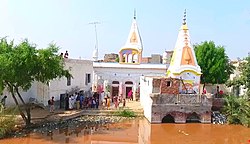| Baba Ram Thaman Shrine | |
|---|---|
 Baba Ram Thaman Shrine | |
| Religion | |
| Affiliation | Hinduism |
| District | Kasur District |
| Deity | Krishna [1] |
| Location | |
| State | Punjab, Pakistan |
| Country | |
| Coordinates | 31°09′40.7″N74°16′27.3″E / 31.161306°N 74.274250°E |
| Architecture | |
| Architect | Baba Ram Thaman Bairagi |
| Type | Hindu temple |
Baba Ram Thaman Shrine is a Hindu Shrine located in the Khala Kharu village, in Kasur District in the Punjab province of Pakistan. The Shrine is dedicated to Ram Thaman, a 16th-century Vaishnav saint. The Shrine is famous for its annual Vaisakhi fair. [2] The Shrine is a Smadh i.e. a sacred space constructed over the ashes and burial ground of a Hindu saint. [3] This is the one of 36 Dwaras of Ramanandi Sampradaya of Vaishnavas. [4]



